Kill Screen Magazine's Blog, page 236
August 26, 2015
Minecraft is now being used to recreate impressionist paintings
Because of its nature as a sandbox game closer to LEGO than anything else, Minecraft has been used to construct entire cities from famous works of fiction, blocky versions of real-world places, and even a bipedal war robot made of slime and TNT cannons, but it isn't unheard of to see 2D art recreated with Minecraft's palette of colorful cubes, too.
a moody, abstract work rendered in the bulky cubes of Minecraft
With the freedom of Minecraft's Creative mode, players have made 2D art ranging from retro-style pixel art sculptures to this intricate "painting" of Kerrigan from StarCraft, which took 23 weeks and over one million hand-placed blocks.
Now, there’s this: a Minecraft version of the impressionist painting Hard Rain by Leonid Afremov. It isn’t quite as bright as an Afremov, but the color palette is there in all its brilliant purples, blues, greens, oranges.
It’s interesting to see such a moody, abstract work rendered in the bulky cubes of Minecraft, especially one that works in screenshots, as a 2D recreation of a painting, and as a 3D space that reveals each impressionistic "brushstroke" as strange, floating objects when viewed at different angles.
The proportions of the structures on display here are huge, which allows for a level of detail (mostly with the burning gas lamps and multicolored raindrops) that standard Minecraft structures can’t normally obtain. The creator even emulated the reflections in the asphalt using stripes of colored blocks. You can see all of this in the video "tour" of the painting above.
Minecraft was also recently used to host a number of brutalist structures.
See more screenshots or download the level from Planet Minecraft.
Is Deus Ex Human Revolution Truly Transhuman?
Deux Ex envisions a fascinating, half-formed future.
August 25, 2015
Infiniti's breathtaking "Dream Road" 360�� video
Drive over 3,000 miles via virtual reality in the impressive Q60 concept car.
Finally, a game where you're the Tamagotchi and a kid toys with you
Don’t let their ostensible cuteness fool you: Tamagotchi, like babies and pets, are evil little monsters.
That may not be an empirical fact, but it is the worldview of Hitogochi, a game that reimagines the Tamagotchi-human relationship from the perspective of the toy. A new human arrives in your life. She is all excited to get to know you. She asks you lots of questions, virtually all of them asinine. It’s exhilarating to have someone focus so much on your needs—or at least it is at first, but the transactionalism of his relationship quickly grows exhausting. “Why is this person constantly asking me what I want to do,” your character seems to ask itself, and you’d be hard-pressed to disagree.
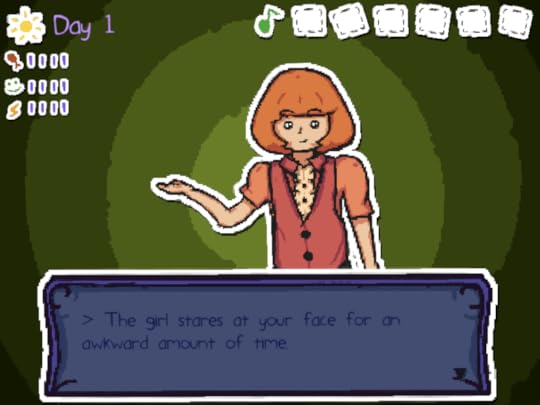
Hitogochi handles this fatigue in a manner that anger counselors would probably discourage. (To say any more would kill all the fun.) Nevertheless, the frustration that motivates this twist is well observed. The Tamagotchi thrived on a weird form of attention, delivered in concentrated bursts. This sort of hot-and-cold, controlling behavior would be maddening in any sort of human interaction. In the case of the Tamagotchi, then, it is only justifiable because toys aren’t human. This is fair enough—toys aren’t people, after all—but it’s not exactly a compelling argument. Insofar as the Tamagotchi was a tool to develop a sort of social skills, it’s strange that we never thought about all those interactions from the Tamagotchi’s perspective. Hitogochi is therefore a useful corrective to one of the 90s’ silliest trends.
Hitogochi is available for Mac, PC, and Linux on Onionblaze's Itch page
Forest of Sleep is like a Russian storybook come to life, by creator of Proteus
Described as an “experimental storytelling/adventure game inspired by Russian fairytales,” Forest of Sleep is a collaboration by Proteus creator Ed Key, artist Nicolai Troshinsky, and a few others. A few glimpses of its storybook-style art hit Twitter last week, but now there’s a new website revealing more information about the game’s unique take on adventure games.
dynamically improvised short stories
Besides its art, the big thing about Forest of Sleep is the way it combines story elements to produce what its creators describe as “dynamically improvised short stories.” Since the team at Twisted Tree Games are still speaking about it rather abstractly, it’s not yet super clear what this means: there’s talk of “emergent associations” and “cinematic language” over on its website.

Another interesting element is that the game will feature no text, so not only will things like character expressions and context be key to understanding the course of a story, but Forest of Sleep can likely also be enjoyed no matter what the player’s native language is, free of the need for localization.
Forest of Sleep will follow a basic structure at first, following three children as they journey “between kingdoms and landmarks,” helping strangers along the way. Twisted Tree also mentions a resource management system, which will be there to add rhythm to adventures rather than serve as a “do-or-die mechanic.”

Making up for all the things we don’t know about Forest of Sleep yet are a ton of new screenshots, showing off its Eastern European-inspired art style, influenced by artists like Janusz Stanny, Stepan Zavrel and Yuri Norshtey.
According to its creators, hand-made assets are procedurally placed with code to create the busy, layered scenes on display in many of these shots. Take the one above for example: rolling farmland glimpsed in the spaces between trees, which stand tangled among tall grass, rocks, and cabins in the foreground, while a cast of characters dot the sparsely colored landscape.
Check the screenshots out below or head over to Forest of Sleep ’s website for more.
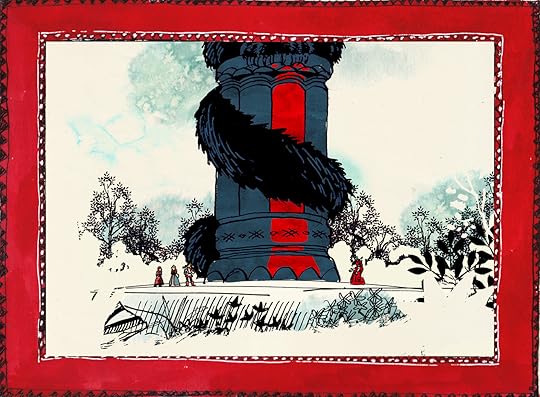
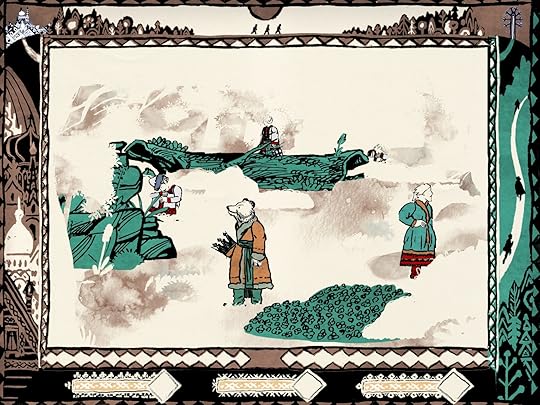
The meaninglessness of your Tinder existence, in videogame form
Stave off the cold grip of death by swiping right over and over and over again.
Until Dawn and the ���final girl���
Where does Until Dawn fit into the history of slasher flicks?
The Omnivore's Dilemma finally has a videogame incarnation
In the interest of full disclosure, let me start by confessing to my carnivorous ways. I enjoy eating meat, and lots of it please and thank you. Braised, roasted, grilled, cured, tartare, barbequed, sous-vide—you name it, I’ll eat. I cannot present you with a compelling ethical argument in defense of this diet. Sure, I can make an impassioned speech about treating animals humanely whilst they live, but I’m in favour of killing them for my gustatory pleasure so such a statement would probably carry little weight. All I can really say is that if the cleaver were in the other hoof, I’d fully expect the animals to eat me for dinner. What I lack in moral fiber I make up for in logical consistency.
If the cleaver were in the other hoof, I’d fully expect the animals to eat me for dinner
That Cow Game, an entry in the latest Ludum Dare game jam, takes this worldview to a logical conclusion. It imagines a meatpacking plan in which human carcasses are suspended on meat hooks and cows supervise their butchery. At the start of the assembly line, the humans are whole, albeit hanging upside down. Shortly thereafter, blood is streaming from their corpses and pooling on the ground beneath them. Before you can say, “I’m not sure how I feel about this,” their bodies have been butchered into parts and are headed down a conveyor belt. At this point you might want to stop everything and declare that, having given the issue a bit more consideration, vegetarianism is indeed the way to go. But it’s too late. Those arms, legs, and ribs are now in sealed packages and being dumped into the back of a refrigerated truck.

There’s very little for you to actually do in That Cow Game. You walk around and take in this new world. That’s it. This is not a game that is interested in granting you more agency than is absolutely necessary. Any resemblance to a horror flick in That Cow Game is largely incidental: the experience exists to replicate commercial practices as opposed to the formal conventions of genre cinema. If those two things look the same to you…well, maybe it’s time to rethink your dietary habits.
That Cow Game did not convince me to give up meat. I’m a stubborn glutton. Nevertheless, I mainain That Cow Game serves a useful function. In all forms of consumption, it’s worth reckoning with the ways in which products we enjoy are made and the moral choices that they embody. Ideally, this would lead to more ethical behavior, but a bit more self-awareness is a decent start. That Cow Game tests the limits of what carnivores find palatable, and forces them to live with their decisions. That’s hardly a revolutionary accomplishment, but it’s a decent start.
You can download That Cow Game on developer Normand's Itch page.
With its new expansion, Hearthstone is crumbling under its own weight
Long live the arena.
Prehistoric survival sim Before is showing off new screenshots
Before is yet another survival game, but unlike most of the post-apocalyptic zombie fests that dominate the genre now, Facepunch Studios has set their world in a time long before modern civilization even existed: the era of cave-dwellers and mammoths, grass huts and spears.
The latest blog post outlines a few of the primary systems that will drive Before’s prehistoric simulations and provides a glimpse at some of these systems in action. It doesn't seem like much is happening in the videos, but creator Bill Lowe assures that there’s “a lot going on behind the scenes.” There are also some new screenshots to check out.
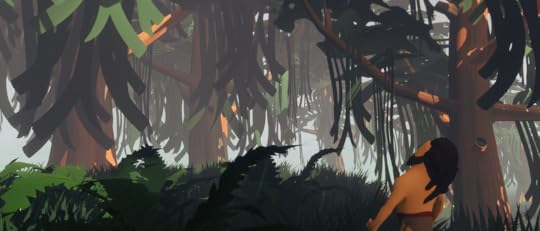
In the videos, which you can see on Before’s blog, the game’s newly spawned cave people scurry about a grassy clearing collecting fruit, piling up wood on a fire, and sneaking through the swamplands to avoid a giant crocodile.
All the while, an ambient track layered with swelling strings and slow, melodic keyboard generates a tone of curiosity to mark the early adventures of this young tribe.
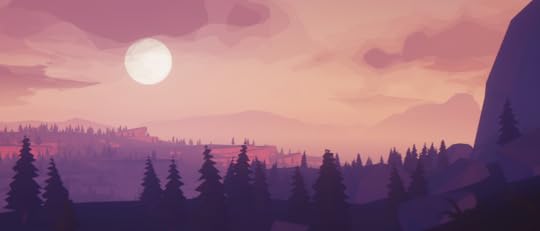
According to Lowe, Before’s core systems are the Decision Making system, Smart Objects, and Influence Maps. He doesn’t go into much detail about how these work yet, but does explain how something like influence mapping, along with the AI work the team has been doing, can generate instincts in animals, like herd behavior and avoidance of predators.
Bits and pieces of Before have been floating around the internet for over a year now, but the most substantial look at it came in the form of its first trailer, which premiered during The Game Awards last December.
Lowe writes that the next update should come sometime in September, so if you’re interested in survival sims, keep an eye out.
You can read more about Before on its website.
Kill Screen Magazine's Blog
- Kill Screen Magazine's profile
- 4 followers



